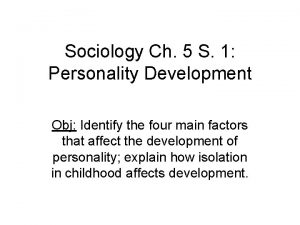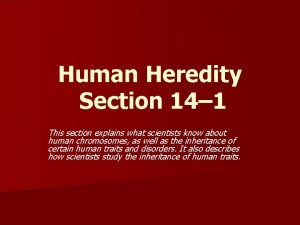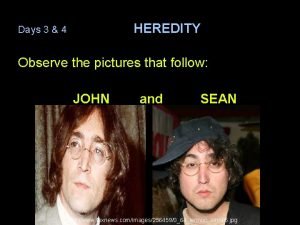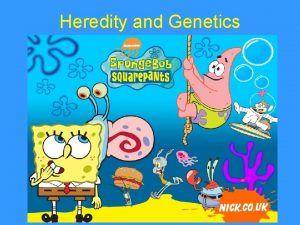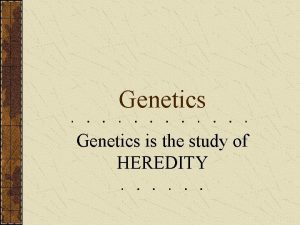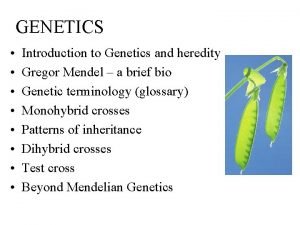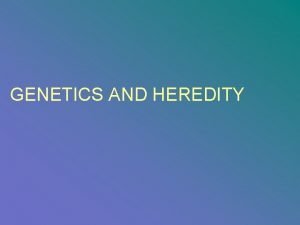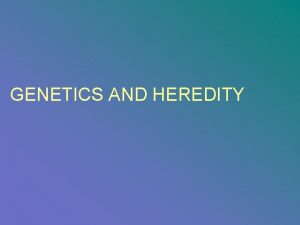GENETICS THE SCIENCE OF HEREDITY Nitty Gritty Science



















- Slides: 19

GENETICS: THE SCIENCE OF HEREDITY Nitty Gritty Science, LLC © 2016

The Work Of Gregor Mendel Nitty Gritty Science, LLC © 2016

Genetics — is the scientific study of heredity Photo by Darekk 2 / CC BY-SA Heredity — the passing on of characteristics from parents to offspring. These characteristics are called traits. Nitty Gritty Science, LLC © 2016

Gregor Mendel, an Austrian monk, discovered important facts about heredity using garden peas. Garden peas produce male and female sex cells called gametes. Fertilization occurs when the male and female reproductive cells join forming a zygote. The zygote becomes part of a seed. Nitty Gritty Science, LLC © 2016

Mendel used true-breeding peas, meaning if they were allowed self-pollinate, they would produce offspring identical to themselves. Mendel studied seven traits of pea plants, but only studied ONE trait at a time, for example to see how height was passed from parent to offspring. Mendel took pollen from a true-breeding tall pea plant and cross-pollinated a true-breeding short pea plant. Nitty Gritty Science, LLC © 2016

Hybrid Offspring of parents that have different forms of a trait. Since only one trait was different the offspring is called a monohybrid. Parents Offspring of F 1 generation P 1 generation F 2 generation Nitty Gritty Science, LLC © 2016

Mendel’s Laws Of Heredity Nitty Gritty Science, LLC © 2016

Mendel concluded that biological inheritance is determined by factors that are passed from one generation to the next. These factors that determine traits are called genes. Alleles — different forms of genes, such as genes for height can either produce genes for tall plants or genes for short plants. Nitty Gritty Science, LLC © 2016

FIRST LAW Law of Segregation — every organism has two alleles of each gene and when gametes are produced the alleles separate. Nitty Gritty Science, LLC © 2016

Phenotype — the way an organism looks and behaves (tall or short) Genotype — the allele combination of an organism (TT, tt, Tt) An organism is homozygous for a trait if the two alleles for the trait is the same. (TT — homozygous dominant; tt — homozygous recessive) An organism is heterozygous for a trait if its two for the trait are different (Tt). Nitty Gritty Science, LLC © 2016

SECOND LAW Law of Independent Assortment — genes for different traits are inherited independently of each other. *In a dihybrid cross (two traits) you can see both of Mendel’s Laws at work. Nitty Gritty Science, LLC © 2016

Punnett Squares Nitty Gritty Science, LLC © 2016

Reginald Punnett came up with Punnett Squares to predict the proportions of possible genotypes in offspring. one parent’s genotype T other parent’s genotype t T Punnett square for a single trait t Nitty Gritty Science, LLC © 2016

Monohybrid Cross: Heterozygous Plants Parent 1 (Tt) x Parent 2 (Tt) T t TT Tt Tt tt Crossing two pea plants that are heterozygous for seed color (Tt) will produce offspring in the following ratio: 1/4 = TT (Homozygous Dominant) 2/4 = Tt (Heterozygous) 1/4 = (Homozygous recessive) Nitty Gritty Science, LLC © 2016

Monohybrid Cross: Homozygous Plants 4/4 = Tt (Heterozygous) t t T T Tt Tt A cross between a yellow homozygous plant (TT) with a homozygous recessive green plant (tt) only produces heterozygous yellow (Tt) offspring. *A Punnett square can also be created for dihybrid crosses — it would be four boxes wide and four boxes tall. Nitty Gritty Science, LLC © 2016

Meiosis Nitty Gritty Science, LLC © 2016

Meiosis — a type of cell division that produces four cells, each with half the number of chromosomes as the parent cell. In animals, meiosis occurs in the sex organs — the testes in males and the ovaries in females. Nitty Gritty Science, LLC © 2016

A gamete, or sex cell is a haploid cell, meaning this cell contains only one of each kind of chromosomes versus a diploid cell found in body cells, which have two of each kind of chromosome. Nitty Gritty Science, LLC © 2016

*Mitosis results in the production of two genetically identical diploid cells, whereas meiosis produces four genetically different haploid cells in two stages known as the 1 st and 2 nd meiotic divisions. Nitty Gritty Science, LLC © 2016
 Nitty gritty science
Nitty gritty science Look at the following pictures
Look at the following pictures Genes is the study of heredity and variation
Genes is the study of heredity and variation Chapter 17 lesson 2 heredity and genetics
Chapter 17 lesson 2 heredity and genetics The gritty life
The gritty life Gritty student
Gritty student Gritty student
Gritty student Spherical harmonic lighting: the gritty details
Spherical harmonic lighting: the gritty details Brainpop heredity worksheet answer key
Brainpop heredity worksheet answer key An unchanging, biologically inherited behavior pattern.
An unchanging, biologically inherited behavior pattern. Heredity concept map
Heredity concept map Section 3 mendel and heredity
Section 3 mendel and heredity 14-1 human heredity
14-1 human heredity Heredity is best described as the -
Heredity is best described as the - Pictures of heredity
Pictures of heredity Allele
Allele Genetics
Genetics ____________ is the study of heredity.
____________ is the study of heredity. Homozygous
Homozygous Chapter 11 human heredity section 11-3
Chapter 11 human heredity section 11-3









